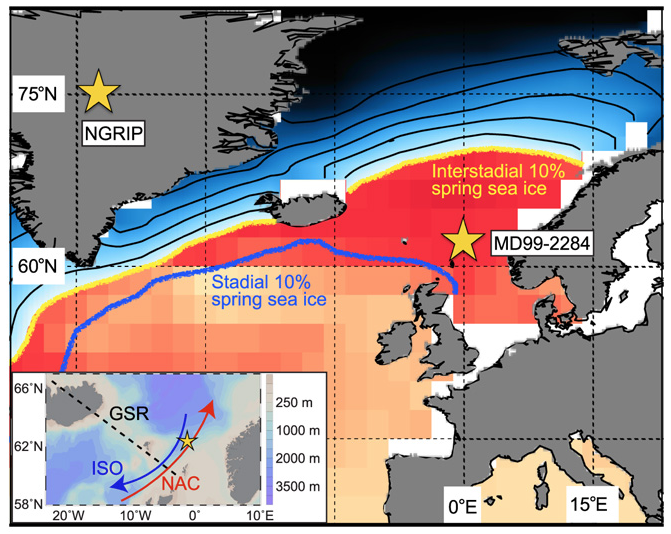A recent study on ‘Sea ice variability in the southern Norwegian Sea during glacial Dansgaard-Oeschger climate cycles’ co-authored by Axel Timmermann, the Director of the IBS Center for Climate Physics has been published in the journal Science Advances on March 7, 2019. This study provides evidence for substantial variations in past sea ice cover in the Norwegian Sea, which were instrumental in triggering and amplifying global abrupt climate change during the last glacial period.
“Using paleo-climate data as well as computer model simulations, this study highlights the importance of ice-ocean interactions in abrupt climate change. Future research in our center will further elucidate the mechanisms responsible for some of the largest and most rapid disruptions of our climate system – the so-called Dansgaard-Oeschger events”, says Axel Timmermann.

The last glacial period, 10,000–100,000 years ago, was marked by repeated abrupt climate changes that had global implications and comprised temperature shifts of up to 15°C over the Greenland ice sheet happening within decades. While the underlying mechanisms of these so-called Dansgaard–Oeschger climate events are not yet fully understood, a new study confirms that changes in sea ice cover in the Norwegian Sea played a key role in driving these enigmatic events. The new results indicate that initial sea ice reduction started before the abrupt warming over Greenland, and that sea ice expansion started before the end of the warm periods in Greenland.
Henrik Sadatzki, who recently defended his PhD thesis at the Department of Earth Science and Bjerknes Centre for Climate Research, University of Bergen, led the study in collaboration with colleagues from various international institutions. The researchers investigated specific organic molecules in a sediment core from the southern Norwegian Sea, one of which was produced by algae that live in sea ice and others that were produced by organisms living in open, ice-free waters thousands of years ago. The new sea ice reconstruction based on organic molecules in marine sediments was also evaluated by means of results from a model simulation of past sea ice conditions.
“Our data suggest that there were substantial changes in the sea ice cover in the southern Norwegian Sea between 32,000 and 40,000 years ago. Most extensive sea ice conditions occurred at the onsets and early parts of cold periods over Greenland and the most pronounced open-ocean conditions occurred at the onsets of the abrupt changes to warm periods over Greenland”, Sadatzki says.
The new results presented by Sadatzki and his colleagues support that an enhanced sea ice cover contributed to insulation of the cold, high-latitude atmosphere from relatively warmer waters that were present in the Norwegian Sea beneath the sea ice lid. In turn, sea ice reduction allowed for heat release from the exposed Norwegian Sea waters to the atmosphere, which was a prime ingredient in shaping the abrupt warming of the Dansgaard-Oeschger climate events in Greenland.
The Dansgaard–Oeschger climate events have stirred lots of interest in documenting that the climate system contains mechanisms that may lead to large abrupt and surprising climate changes. “Our results form a major step forward in our understanding of abrupt climate changes”, Sadatzki says. The new observations suggest that the sea ice changes in the southern Norwegian Sea were an integral part of oceanic and atmospheric processes, which led to the abrupt glacial climate changes in Greenland and over large parts of the world.
Reference
H. Sadatzki, T. M. Dokken, S. M. P. Berben, F. Muschitiello, R. Stein, K. Fahl, L. Menviel, A. Timmermann, E. Jansen, Sea ice variability in the southern Norwegian Sea during glacial Dansgaard-Oeschger climate cycles. Sci. Adv. 5, eaau6174 (2019).